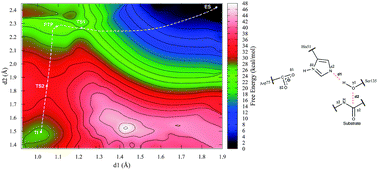Reaction mechanism of the dengue virus serine protease: a QM/MM study†
Abstract
The dengue virus (DENV) is the causative agent of the viral infection dengue fever. In spite of all the efforts made to prevent the spread of the disease, once it is contracted, there is no specific treatment for dengue and the WHO guidelines are limited to rest and symptomatic treatment. In its reproductive cycle, DENV utilizes the NS2B-NS3pro, a serine protease, to cleave the viral polyprotein into its constituents. This enzyme is essential for the virus lifecycle, and presents an attractive target for the development of specific dengue treatments. Here we used a hybrid Quantum Mechanics and Molecular Mechanics (QM/MM) Molecular Dynamics approach and Umbrella Sampling to study the first step (acylation) of the reaction catalyzed by NS2B-NS3pro, using the Pairwise Distance Directed Gaussian PM3 (PDDG/PM3) semi-empirical Hamiltonian for the QM subsystem, and Amber ff99SB for the MM subsystem. Our results indicate that the nucleophilic attack on the substrate by Ser135 occurs in a stepwise manner, in which a proton transfer to His51 first activates Ser135, which only later attacks the substrate. The rate-determining step is the Ser135 activation, with a barrier of 24.1 kcal mol−1. Water molecules completing the oxyanion hole stabilize the negative charge formed on the carbonyl oxygen of the substrate. The final step in the process is a proton transfer from His51 to the substrate's nitrogen, which happens with a lower barrier of 5.1 kcal mol−1, and leads directly to the breakage of the peptide bond.

- This article is part of the themed collection: Insights from advanced methods in molecular dynamics


 Please wait while we load your content...
Please wait while we load your content...